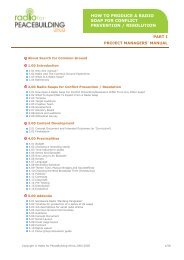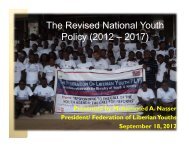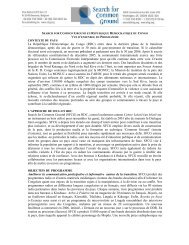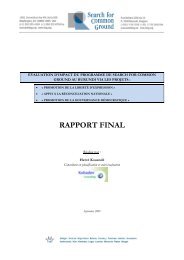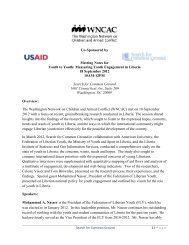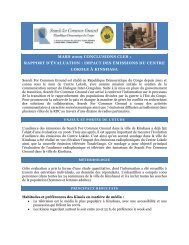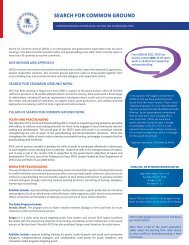The Common Ground Network for Life and Choice Manual
The Common Ground Network for Life and Choice Manual
The Common Ground Network for Life and Choice Manual
You also want an ePaper? Increase the reach of your titles
YUMPU automatically turns print PDFs into web optimized ePapers that Google loves.
language, insuring underst<strong>and</strong>ing between the parties, <strong>and</strong> exhibiting fairness. Neither mediation<br />
that seeks movement towards a negotiated settlement, nor facilitation designed <strong>for</strong> planning <strong>and</strong><br />
decision-making typically makes these dem<strong>and</strong>s to the same degree.<br />
<strong>The</strong> Appendices at the end of this chapter contain more detailed guidelines <strong>for</strong><br />
facilitation, including specific direction <strong>for</strong> leading dialogue sessions. <strong>The</strong> following provides an<br />
overview <strong>and</strong> background <strong>for</strong> these materials.<br />
Summary of the Facilitation Role<br />
<strong>The</strong> facilitator is present to make sure that, to the degree possible, participants have the<br />
conversation they have come to experience. To that end, the dialogue facilitator has to pledge to<br />
the following:<br />
• To be solely committed to the process, allowing the group to focus on the substantive<br />
conversation. This means staying out of the substantive dialogue <strong>and</strong> not injecting an<br />
outcome the facilitator thinks is desirable, or in<strong>for</strong>mation the facilitator believes would<br />
resolve a factual dispute or “correct” a party. In a dialogue, the “experts” on the abortion<br />
issue are the participants, not the facilitator. If something needs to be learned, the<br />
participants must decide how to get that in<strong>for</strong>mation or resolve the factual disagreement.<br />
Any <strong>for</strong>ay by the facilitator into the substance of the conversation is reckless given the<br />
sensitivity of participants about bias or cooptation.<br />
• To take an elicitive stance so that, to the extent feasible, the learnings, insights <strong>and</strong> questions<br />
come from the participants. This does not mean that a facilitator never offers an insight or<br />
reflection of what he or she is hearing from the group, but in our experience this should only<br />
happen when the point is too important to be lost, the participants have had the first chance,<br />
<strong>and</strong> the facilitator offers his or her input as a hypothesis with which the participants can agree<br />
or disagree. (E.g, “My perception is that everyone here is upset with how children are<br />
treated in this society. Are you hearing that, too?”)<br />
• To be absolutely fair. To avoid a perception of bias, a facilitator has to play a neutral role.<br />
This does not mean having no position on abortion; it means keeping that position out of the<br />
room while you function as a facilitator. This requires that, in advance, a person considering<br />
a facilitation role reflect honestly on whether he or she can be even-h<strong>and</strong>ed, calm <strong>and</strong> use<br />
balanced language (i.e., can avoid using the labels the sides use <strong>for</strong> their opponents, like antichoice<br />
or pro-abortion) in a discussion relating to abortion. During the dialogue not only<br />
language but also gestures <strong>and</strong> non-verbal communication are important. Everyone has<br />
issues they should not facilitate<br />
• To be compassionate <strong>and</strong> empathetic. This stance puts participants at ease <strong>and</strong> models the<br />
attitude you hope to elicit from everyone. A facilitator’s sensitivity can really help<br />
participants who start out suspicious or fearful.



